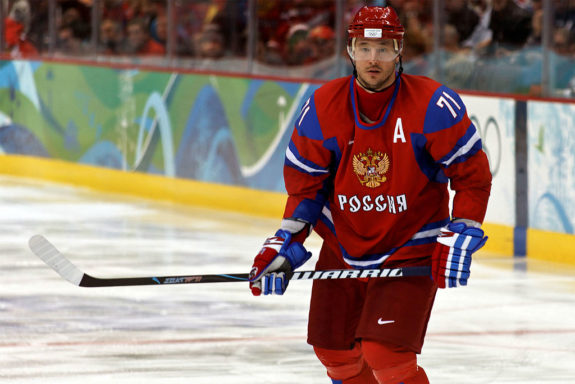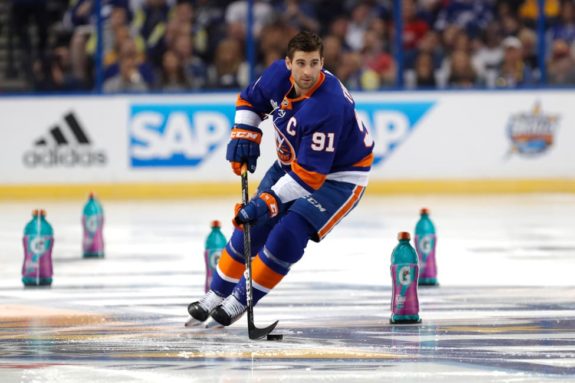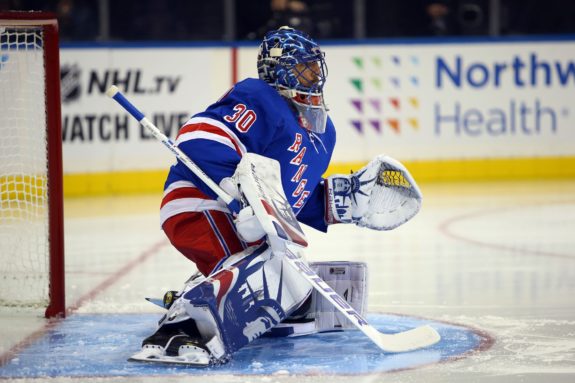As the old saying goes, in sports you can either sell wins or hope. Though in stark contrast to the winning product they’ve been accustomed to selling since the 2005 lockout, as of February’s letter of intent, the New York Rangers are now officially in the hope-selling business. This marketing shift comes with a new strategy designed to return the Blueshirts to the league’s upper echelon and take home a fifth Stanley Cup.
But just how long do the Rangers expect to be hope sellers?
While there’s no ironclad blueprint for how to build a Cup-contender, most hockey experts would agree that strong drafting and even two or three strategically sacrificed seasons—ordinarily referred to as “tanking”—offer a rebuilding club the highest chance of acquiring the kind of game-breaking talent needed to build a team around. Combine that with key free agent signings and/or an opportunistic trade or two, and you’re running for glory.
Yet the Rangers appear to have a much faster pace in mind. One that, for all intents and purposes, would theoretically see the team advance from eighth-worst in the league to a contender as soon as next year. It’s a lofty goal, not without significant risk, but by every measure appears to be the path they’re set on taking – consequences be damned.
Rangers to Accelerate Rebuilding Rate?
“There’s already the reports out of Russia that Kovalchuk is coming, right,” said Elliotte Friedman on the latest edition of the 31 Thoughts podcast, before questioning the commitment of New York’s rebuilding plans.

“How much is this really a rebuild? And you’ve got to have kids. You can’t be successful without kids,” he noted.
In selling off Rick Nash, Michael Grabner, Nick Holden, Ryan McDonagh, and J.T. Miller this season, the Rangers did manage to bring in a number of high-quality prospects to replenish a barren prospect pool. At some point in the near future, MSG will be home to former first-round pick Brett Howden, as well as defensemen Libor Hajek, Ryan Lindgren, and Yegor Rykov, all of whom will join last year’s first-round picks, teenagers Lias Andersson and Filip Chytil.
The Blueshirts also managed to acquire a large number of selections in the draft to the tune of seven picks in the first three rounds, including a league-leading three selections in the first round. But they don’t seem set on making picks with all of them. On the contrary, according to TSN’s Bob McKenzie, they may look to package some combination of them in order to move up in the draft and/or to acquire a 21- to 23-year-old to speed up their effort.
That alone would qualify as accelerated. Yet they’re also directly linked to Kovalchuk, and pending free agents John Tavares and Erik Karlsson. Acquiring just one would give them a jump off the line. If they could land more than one, they’d red line the team’s proverbial tachometer.
“… I don’t think we’re really going to know until the summer, after the draft and free agency, what kind of thing the Rangers are really looking at. I think there’s a chance they go for one or two bigger guys and try to fill in with the kids and see if the enthusiasm can carry them over,” Friedman went on to say.
“Karlsson could make a lot of sense there to me too, but not for a year,” he added.
Why Accelerating is Dangerously Ambitious
Even by conservative estimates—putting aside for the moment the wealth of salary cap concerns it would likely create, even with an estimated $25 million in available cap room this summer—the prospect of adding even one, let alone all, of Kovalchuk, Tavares, and Karlsson would hasten the Blueshirts’ plans by a significant factor.

In Tavares, the Rangers would be acquiring a franchise center capable of carrying the load in a first-line role that can make a difference on the scoreboard on any given night. As a quick sidebar, while I know Rangers goalie Henrik Lundqvist has done an admirable job carrying the organization in this respect, contrary to popular belief, goalies can’t actually win games. They can only keep you alive long enough for a skater to make the difference – something the Rangers have lacked first-hand for years.
Kovalchuk, expected to sign a two-year contract, even at the age of 35, can likely be counted on for 25 to 30 goals if not more (especially if he’s joined by Tavares). And Karlsson, injuries and all, remains the prototype for a modern-day, game-breaking defender. His combination of skating, speed, puck control, vision, and shooting make him supremely unique on the defensive market.
Tavares and Kovalchuk can be had for nothing more than money. Both will be unrestricted free agents (UFA) this summer. Karlsson, however, would cost the team a considerable collection of assets given he’s a full year away from free agency. It’s here, most of all, that the Rangers’ rebuild, insofar as traditional rebuilds are defined, appears to jump the shark if Karlsson remains a target heading into next year.
Youth movements require the presence of veterans, often high-priced ones, to serve in much-needed leadership roles. Not to mention the added benefit they bring in helping clubs, especially those with a high number of low-priced entry-level contracts (ELC), in meeting the salary cap floor. But acquiring Karlsson, in particular, would cost the Rangers a haul of valuable, cost-controlled assets. Assets they could otherwise keep to theoretically draft a younger version of him in June.
#NYR offers Skjei, Buch, 8 overall to #sens for EK65, assuming extension to be announced in July.
Who says no?
— MV (@MikeyVoodoo) April 12, 2018
If the Rangers do pull it off and land the Superstar Swede, their prospect losses could be mitigated through additional trades this summer. Mats Zuccarello, who will turn 31 before next season, has been linked to the market since February, if not prior. There’s also a slew of restricted free agents to keep in mind. It’s possible the Big Five—Kevin Hayes, Brady Skjei, Vladislav Namestnikov, Ryan Spooner, and Jimmy Vesey—wouldn’t all be retained regardless, but the Rangers could liquidate one or more for additional futures.
In many ways, these types of ancillary trades would become a requirement of this vision of a rebuild, if only to respect the salary cap ceiling. But their biggest value would come in replenishing the prospect pipeline that would no doubt be affected should management acquire Karlsson. Giving up a top-ten pick, for example, hurts. But it hurts less knowing you’ve landed Erik Karlsson and even less if the Rangers are able to parlay someone like Zuccarello into another first-rounder.
Acceleration is Risky but Required to Win with Lundqvist
All-in-all, the concept of acquiring Karlsson is a viable one, but it’s not without significant risk. A risk that the Rangers, who’ve only just begun the arduous task of rebuilding a long-term contender, wouldn’t be wise to accept under normal circumstances. That said, these aren’t normal circumstances. Like it or not, with Lundqvist in the fold, the Rangers were never going to sacrifice his remaining years by taking a more traditional route to stockpiling key assets.
As Chris Nichols of FanRag Sports notes:
An argument could be made that a ‘rebuilding’ team shouldn’t be parting with young assets and/or draft picks to get an older player. The counter to that point of view, though, is that the Rangers may well be going for a quick reset rather than a conventional rebuild. In that case, Karlsson will only be turning 28 at the end of May and he should still have a number of elite years remaining. Opportunities to land a player of his magnitude are few and far between, so seizing this rare opportunity may well make sense for this franchise.
The Lundqvist factor is one that, above all, must be accounted for. Though the future Hall-of-Famer noted to the Rangers months ago that no matter the outcome, he was in it for the long haul, he also turned 36 this past March.

“Next year has to be about winning and nothing else,” the goaltender told the New York Post on April 2. “I understand that the end now has been about the young guys getting used to the league and getting confidence, but next year is not about the process. It’s about winning games.”
In expanding on his position, he spoke to the value of setting expectations high for rookies and young players who will be playing on the roster next year:
“It’s important that the guys who are here for the first time understand they need to compete. That is what we expect here. If [our veterans] had seen that the front office was encouraging tanking, that would not have been appreciated, absolutely not. You want to be a part of a group that’s doing everything it can to win, no matter what the circumstances,” Lundqvist said.
So it stands to reason, the Rangers front office won’t encourage it at all. Instead, they’re far more likely to make bold moves to impel next year’s squad right back to the playoffs with a reinvigorated group. Perhaps one led by an amalgamation of highly-talented veterans like Tavares, Kovalchuk, and/or Karlsson, with any remaining holes in the roster filled from within their prospect pool.
Is it baptism by fire for the youngsters lucky enough to land opening night roles? You bet.
While asking rookies to play key roles is always risky, it’s a problem that a Rangers squad spearheaded by any combination of Tavares, Kovalchuk, and Karlsson could easily alleviate, which would go a long way in a short amount of time to getting the franchise back to selling wins again – a feeling they’re no doubt yearning to return to as quickly as possible.